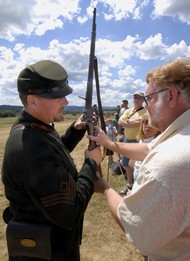
| Home | Tactics | Monuments |Schedule | Links | Contact Us | Literature | Hiram Berdan | Photo Gallery | Wanted | About Us | Guestbook | Regiments | Members Only Relics | Terminology | Rifle Care | Art Gallery | Sharps Rifle | USSS Forum | USSS CDV's |
|---|

| July 2007 Antietam Technology of War |
A demonstration in history
Weaponry buffs learn war technology at weekend Antietam events
Originally published July 23, 2007
By Sarah Fortney
News-Post Staff
The infantry and sharpshooter demonstrations, as well as the ranger-led battlefield tours, attracted hundreds of people to the historic site Saturday and Sunday. Historian Marion Armstrong of Nashville, Tenn., displayed more than a dozen original rifles used in the Civil War, many of which could only fire about two to three shots per minute, he said Sunday. Armstrong explained how firearms evolved over the decades leading up to the Battle of Antietam. On Sept. 17, 1862, 23,000 people were killed or wounded during 12 hours of fighting. Soldiers used the smoothbore, muzzle-loading musket until 1855, Armstrong said. They found it easy to load but lacking in accuracy. Soldiers formed close regiments to increase firing mass and improve communication, he said. The close formations maximized firepower and efficiency. Infantry regiments still used close-group formations after more accurate weapons developed, including the minie ball that could shoot up to 1,250 yards — 1,000 yards more than the small, round musket balls. Because the soldiers did not have radios to communicate, they could not spread apart, Armstrong said. They still needed to stay close to hear commands. Newer weapons combined with old tactics made for mass destruction, Armstrong said. Adolph Woll said he could hardly imagine what the battlefield would have looked like with thousands of soldiers firing at each other, nor could he think of a better place to talk about the Civil War. Woll was on vacation with his son, William Woll, and grandson, Matthew Woll. The three men said they enjoy visiting battlefields and reenactments. The Wolls, of Pompton Lakes, N.J., traveled to the Antietam National Battlefield for the first time this weekend. "(The event) puts it into perspective a little more," William Woll said. |
||||||||||||||
Antietam Volunteers Win 2007 Take Pride In America® National Award
WASHINGTON D.C. — Deputy Secretary of the Interior Lynn Scarlett today recognized the 2007 Take Pride in America National Award recipients at an awards ceremony in Washington, D.C. The individuals and groups from across the country were acknowledged for their outstanding contributions to local, state and federal public lands. This year, there were 18 National Award winners representing 12 states and the District of Columbia.
The Antietam National Battlefield Volunteers were recognized in the Federal Volunteer Program category for their enormous force of dedicated volunteers that have helped to beautify and protect Antietam National Battlefield, ensure its historical accuracy and visitor accessibility. At 2,048 people, the immense size of the volunteer force has allowed it to donate 23,865 hours in the last year alone. The program removed trash from roads and trails, planted trees, constructed fences, and maintained the historic houses. A group of middle school students scrubbed every headstone in the Antietam National Cemetery in preparation for Memorial Day. Nine hundred volunteers placed 23,410 candles during the Annual Illumination in December, accounting for nearly 10,000 volunteer hours. The group also has Living History Volunteers, who provide formal and informal interpretations during the Annual Torchlight Tour, in camp, and during firing demonstrations. Natural Resource volunteers also assisted with scene restoration, cedar seedling removal, and tree planting.
“These are extraordinary individuals and organizations who have tapped into the power of volunteerism to enhance our public lands and improve the experiences of visitors to those lands,” Deputy Secretary Scarlett said
Rider Web Designs
http://www.riderwebdesigns.com
Question Regarding this Website?
email the Webmaster
Website Designed & Created by David Rider
This site was last modified
July 24, 2007
.
Copyright www.berdansharpshooters.com © 2004/2005

